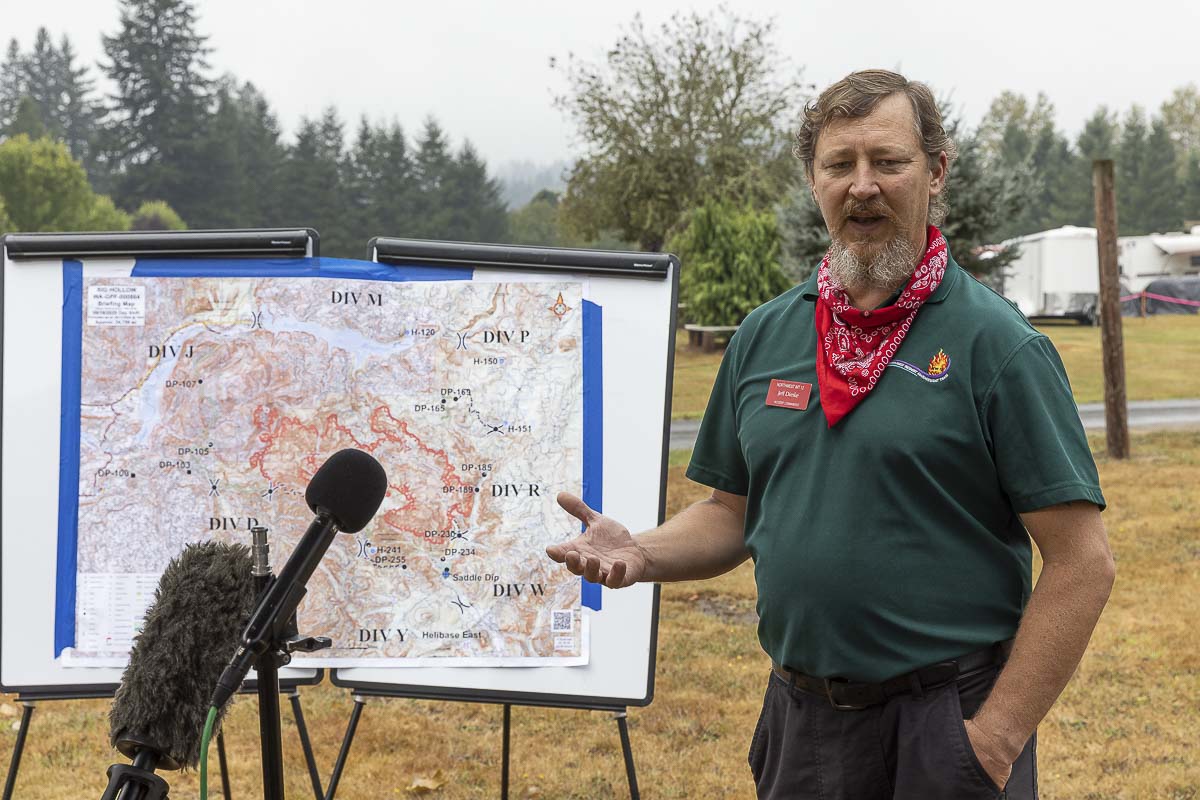Message included admission that limited resources require a confine-and-contain strategy by firefighters
Washington State Public Lands Commissioner Hilary Franz and Northwest Incident Management Team 12 Commander Jeff Dimke gave an update on efforts to fight the Big Hollow Fire on Friday. They were at the Amboy Territorial Park, where they had established their Westside Spike Camp for firefighting crews.
Dimke indicated that because of the significant number of fires on the west coast, resources were spread thin. Therefore, they created a “confine and containment strategy” to fight the Big Hollow Fire. Due to the very challenging terrain and limited resources, Dimke said they will not seek to completely contain the fire. It is presently about 15 percent contained as of Friday, with about 25 percent of their total strategy having been implemented.
Franz and Dimke said their expectation is that the rain and cooler temperatures will allow the fire to hopefully burn itself out, as fire crews deal with hotspots and monitor the fires. Dimke said his crews were mobilized Aug. 17 when they began fighting fires in Oregon. They had a three-day rest and were called back into action for another fire, all before responding to the Big Hollow Fire.
Fire crews are generally allowed to be out for a maximum of 21 days before being given a break. Dimke said his crews would hit the 21-day mark on Sept. 22.

Franz addressed the broader challenges of the current fire season. West Coast states, and even British Columbia, Canada, share resources and assist each other. Washington crews were helping in Oregon and California. Franz indicated things were looking pretty tame for this season until the unprecedented 72-hour wind event that occurred Labor Day weekend. Hurricane force winds caused the rapid spread of the fire.
“We weren’t able to leverage our air resources,” said Franz, who also indicated that airplanes normally drop water and fire retardent, as well as identify other hot spots needing immediate attention. “It was too dangerous to fly.”
A rapid response with the planes and fire crews is key to normally stopping a fire quickly and limiting the damage a fire causes, according to Franz, whose remarks echoed those of University of Washington Climate Scientist Cliff Mass in the last week. (Story here.). Franz said the unprecedented strong easterly winds spreading grass fires in eastern Washington caused the unprecedented spread of the fires. She stated that 90 percent of the fires were initially caused by humans.
There were 56 fires the first day, on Labor Day, and 600,000 acres burned in the first 72 hours. That was more than five times the number of acres burned in 2019. It was more than half the number of acres that burned in 2015, Washington’s worst wildfire year.
Franz strongly addressed the politicization of the fires. “Hot air has never, ever put out a fire,” she said. “It only fuels a fire. More than ever, we need people to stop pointing fingers and saying who’s to blame, and get those fingers to work.”
Franz identified 2.7-million acres of forest that are dead and dying, essentially creating tinder boxes. She indicated that If these forests had been cleared, it would have limited the spread of the fires. When the forests were healthy, what might have been a 100-acre fire becomes a 100,000-acre fire because of all the underbrush and tinder and unhealthy trees.
“We have to remove the dead and dying trees,” she said. “We have to remove the smaller diameter trees.”
Franz described the devastation in the town of Mauldin.
“The fire station is gone,’’ she said. “City Hall is gone. The post office is gone.” Franz said over 80 homes were destroyed, the majority of that small community. Mauldin has 8 volunteer firefighters and one fire engine which was destroyed in the fire.
Franz referred to Paradise, California which burned in 2018, as a reminder that more needs to be done to help smaller communities prepare for fires. That prompted Clark County Councilor Gary Medvigy to ask about resources to better communicate to rural citizens. Medvigy pointed out that there is limited internet service and spotty cell phone service in some of those rural communities, making it difficult to notify residents of those areas about fires and the need to prepare to evacuate, or to evacuate and where to go.

Franz said she is very much in favor of enhancing rural broadband coverage. She referenced the need to create something similar to the Amber Alert system, which notifies people immediately when a child has been abducted. Franz believes we should be able to do the same when it comes to not only wildfires, but other natural disasters and emergencies as well.
Franz talked about a four-legged stool concept for dealing with the fires: education of people regarding fire risks; resources to have immediately available to stop a fire; clearing the dead and dying trees and underbrush, as well as the grasslands; and getting more gaps between the trees so they’re not competing for moisture and nutrients.
“Our forests know how to fight fires,” said Franz. “What they don’t know, is how to fight it when they’re all weakened. Because they’re all weakened, they go up in an enormous amount of intense heat that wipes out even the healthiest trees.”
Franz concluded with “we’ve got to give nature a fighting chance.” She talked about 20-to-50 years of fire suppression efforts that have allowed all the underbrush and unhealthy trees to remain as tinder. The lack of management of the forests is what needs to change; a key piece of her strategy.
At the end of the briefing, Clark County Council Chair Eileen Quiring thanked Commissioner Franz and the fire crews for their efforts to protect property and to fight this fire.




